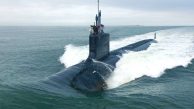
SAN ANTONIO-CLASS AMPHIBIOUS TRANSPORT DOCKS: COST-EFFECTIVE POWER PROJECTION FOR THE FUTURE OF NAVAL WARFARE
US Defence Media Release
WASHINGTON, D.C. – The San Antonio-class Amphibious Transport Docks (LPDs) are transforming the landscape of U.S. naval operations, providing a strategic, cost-effective alternative to traditional aircraft carriers. Engineered to bolster the U.S. Marine Corps’ expeditionary and amphibious warfare capabilities, these advanced vessels are pivotal assets in ensuring American naval superiority.
Essential for First-Strike Operations
Designed to transport over 600 Marines alongside helicopters, landing craft, and combat vehicles, San Antonio-class LPDs excel in Day One operations. These platforms empower Marines to breach enemy defences decisively, delivering the agility and firepower required to establish control in contested environments.
State-of-the-Art Armaments and Intelligence Systems
LPDs are equipped with cutting-edge defensive systems, including 30mm Bushmaster II cannons and Rolling Airframe Missile launchers, ensuring superior protection against aerial threats. Integrated with advanced Next Generation Surface Search Technology, these vessels enhance intelligence, surveillance, and reconnaissance (ISR) capabilities, enabling commanders to dominate rapidly evolving battlespaces.
A Strategic Advantage in the Indo-Pacific
As the Indo-Pacific becomes a focal point for global security, San Antonio-class LPDs provide the flexibility and reach necessary to counter emerging threats. These ships play a vital role in addressing Anti-Access/Area Denial (A2/AD) strategies, safeguarding freedom of navigation, and strengthening alliances through joint training operations. Their versatility makes them indispensable for sustaining U.S. presence and promoting stability across the region.
A Cost-Efficient Alternative to Aircraft Carriers
With the rising costs and vulnerabilities of traditional aircraft carriers, LPDs offer a pragmatic solution for power projection. Costing significantly less than the Ford-class carrier program, San Antonio-class vessels deliver unmatched expeditionary warfare capabilities, ensuring mission success while optimizing budgetary efficiency.
Revolutionizing Marine Corps Operations
In line with its strategic pivot, the Marine Corps is leveraging the San Antonio-class to spearhead amphibious operations. Equipped with Amphibious Assault Vehicles (AAVs), Expeditionary Fighting Vehicles (EFVs), and vertical lift aircraft, these vessels enable Marines to execute high-stakes missions with precision and agility.
A New Era in Amphibious Warfare
The commissioning of USS Richard M. McCool Jr. (LPD-29) highlights the Navy’s commitment to innovation in amphibious warfare. Serving as floating sovereign bases, these ships are integral to joint and combined arms operations, underscoring their importance in both training exercises and real-world missions.
Returning to Amphibious Roots
The San Antonio-class LPDs mark the Marine Corps’ return to its core mission: amphibious warfare. Following years of ground-focused operations, these vessels are instrumental in enabling island-hopping campaigns and maintaining open sea lines of communication in contested waters.
Conclusion
The San Antonio-class Amphibious Transport Docks represent a transformative approach to naval warfare. As the U.S. Navy and Marine Corps adapt to a rapidly changing strategic environment, these vessels offer a powerful blend of innovation, adaptability, and operational efficiency. From enhancing maritime security in the Indo-Pacific to ensuring readiness for future conflicts, the San Antonio-class ensures that the United States remains a dominant force on the global stage.
Photograph: US Navy photo by Mass Communication Specialist 2nd Class Jason R. Zalasky (Released)



